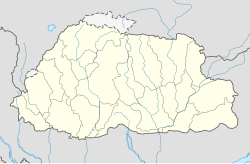| Chimi Lhakhang | |
|---|---|
 View of Chimi Monastery and the chorten | |
| Religion | |
| Affiliation | Tibetan Buddhism |
| Sect | Drukpa Kagyu |
| Leadership | Lama Kinga Norbu |
| Location | |
| Location | Punakha District |
| Country | Bhutan |
| Geographic coordinates | 27°31′37″N 89°52′42″E / 27.5270°N 89.8782°E |
| Architecture | |
| Style | Bhutanese |
| Founder | Ngawang Chogyal |
| Date established | 1499 |
Chimi Lhakhang, also known as Chime Lhakhang or Monastery or temple, is a Buddhist monastery in Punakha District, Bhutan.[1] Located near Lobesa, it stands on a round hillock and was founded and built in 1499 by the Drukpa Kagyu lama Ngawang Chogyal,[2] who was the 14th abbot of Ralung Monastery.[3]
The site was blessed by Ngawang Chogyal's cousin,[3] Drukpa Kunley (1455–1529), who also built a chorten on the site.[4] In preparing and blessing the site it is said that Lama Kunley subdued a demon of Dochu La with his "magic thunderbolt of wisdom" and trapped it in a rock at the location close to where the chorten now stands. He was known as the "Mad Saint" or “Divine Madman” for his unorthodox ways of teaching Buddhism by singing, humour and outrageous behaviour, which amounted to being bizarre, shocking and with sexual overtones. He is also the saint who advocated the use of phallus symbols as paintings on walls and as flying carved wooden phalluses on house tops at four corners of the eaves. The monastery is the repository of the original wooden symbol of phallus that Kunley brought from Tibet. This wooden phallus is decorated with a silver handle and is used to bless people who visit the monastery on pilgrimage, particularly women seeking blessings to beget children.[5][6] The tradition at the monastery is to strike pilgrims on the head with a 10-inch (25 cm) wooden phallus (erect penis).[7] Traditionally symbols of an erect penis in Bhutan have been intended to drive away the evil eye and malicious gossip.[8]
- ^ Pommaret, p.50
- ^ Phuntsho, K. (2016). The History of Bhutan. Random House.
- ^ a b Monson, E. L. (2021). Tales of a Mad Yogi: The Life and Wild Wisdom of Drukpa Kunley. Shambhala. p. 45.
- ^ Pommaret, p.192
- ^ "Bhutan's phalluses warn off evil". British Broadcasting Corporation. 2005-03-25. Retrieved 2010-08-09.
- ^ Brown, p.78
- ^ "Western Bhutan" (PDF). Lonely Planet. Archived from the original (PDF) on 2011-06-08. Retrieved 2010-08-10.
- ^ Aris, Michael; Hutt, Michael (1994). Bhutan: aspects of culture and development. Issue 5 of Kiscadale Asia research series, Kiscadale. ISBN 1-870838-17-3.
